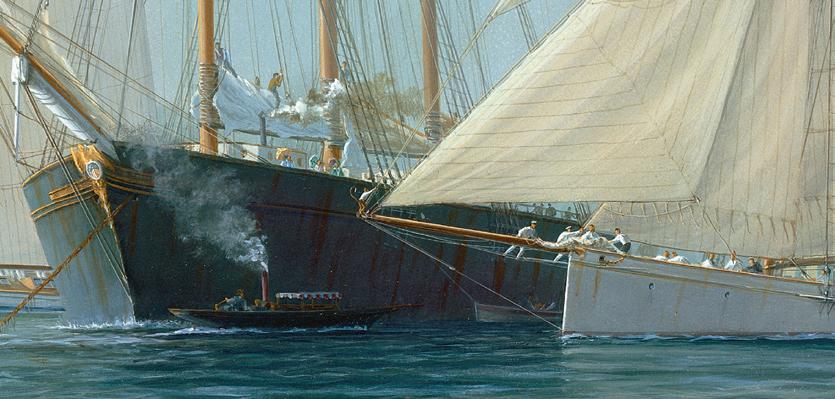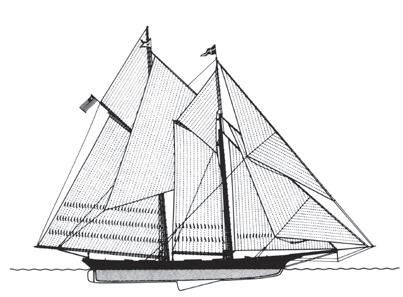
27 minute read
Rogues’ Gallery
1871 colUmbia & sappho defeat livonia
Columbia ‖ New York Yacht Club
LOA: 107ft 10in LWL: 96ft 5in beam: 25ft 6in draft: 5ft 11in draft with board: 22ft displacement: 220 tons sail area: not known owner: Franklin Osgood designer: J. B. van Deusen builder: J. B. van Deusen skipper: Nelson Comstock
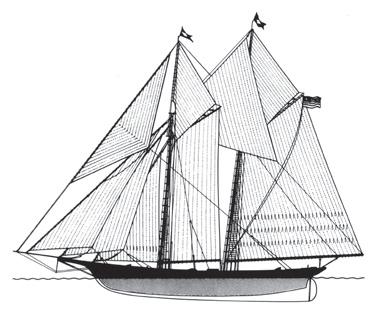
Sappho ‖ New York Yacht Club
LOA: 135ft LWL: 119ft 4in beam: 27ft 4in draft: 12ft 8 in displacement: 310 tons sail area: 9060sq ft owner: Col W. P. Douglas designer: C. & R. Poillon builder: C. & R. Poillon skipper: Sam Greenwood
Directly after his arrival in England, following the defeat of his schooner Cambria in the first challenge for the America’s Cup, James Ashbury asked Michael Ratsey of Cowes to build him a new yacht expressly to win the Cup in 1871. This second challenge caused even greater controversy than in 1870, although it resulted in certain concessions being granted by the New York Yacht Club.
No money was spared on Livonia and she was constructed of oak and teak to combine all that was best in English and American design. But so confident were the Americans in their choice from existing yachts that no new vessels were put on the stocks. However, in his correspondence with the New York Yacht Club before setting out, Ashbury had insisted upon his right to appear as the representative of no less than twelve yacht clubs, with the opportunity to sail twelve races on twelve different days. If he managed to win any one of these races the club he was representing on that day was to be awarded the Cup! The Club held a meeting to consider Ashbury’s proposals, but although they decided that he could represent only the Royal Harwich Yacht Club, they also conceded that he should not be put against the whole of their fleet, as in 1870!
The Livonia sailed for America before the final details had been arranged and Ashbury continued to argue his case in New York until it was settled that he was to sail the best of seven races against any one of four defenders.
On the day of the opening race there were as many spectators present as there had been the year before. Two keel schooners, Dauntless and Sappho, and two centreboard schooners, Palmer and Columbia, had been selected to defend the Cup, but Columbia was the first to establish her superiority over the British boat. Gaining three minutes before the Narrows she never gave Livonia a chance and won by a wide margin.
The next race was to take place on 18 October 1871 from the Sandy Hook lightship 20 miles to windward and return, but on the day a course four points from the wind was the best that the committee could achieve, and by failing to issue clear racing instructions they created a situation not unlike that favouring America in 1851. In a blustery north-westerly, Livonia reached the outer mark ahead of Columbia, who had again been chosen to represent the New York Club, but because her skipper had not been told from which side to round it, he left the mark boat to starboard, as was then the rule in England.
This decision cost Livonia the race. Compelled to gybe because of the wind direction, her sails crashed over with the brute force of a charging elephant, and she was left in such disarray that her crew, including a wretched man stationed aloft to kick over the topsail, took several moments to recover and sharpen up. Quick to take advantage, Mr Osgood on board Columbia steered his vessel between the staggering Livonia and the mark, tacked around it smartly and, stowing his topsails in the strengthening gale, took her speeding home to win comfortably on a reach.
It was apparent that Osgood had asked the committee about rounding the mark, and when Ashbury protested that Columbia had contravened sailing instructions, he was told that: ‘The sailing regulations for the outside course leave the manner of turning the stake-boat optional.’ Ashbury was furious.
Although Dauntless was chosen as defender in the third race, she was disabled while under tow, and because the Sappho and the Palmer were not on hand, Columbia, without her captain who had been injured, was again called to the line. But, expecting a rest day, her crew had been indulging a little too freely and before long Columbia’s flying jib carried away and her steering gear broke. Livonia romped home over fifteen minutes ahead to win the only race of any series to be taken by a challenger until 1920.
The win was not a popular one, and the fourth race was witnessed by only a solitary spectator craft! Sappho, then the largest yacht ever built in America, won easily as she did again in the fifth and final race. But Ashbury did not take his defeat lightly. Claiming the sixth and seventh races, when he had gone to the line but there had been no boat to meet him, the second race won on protest, and the third taken fairly by a distance, he declared that he had won four out of seven contests and the Cup was his!
The committee took no heed of his claims, beyond acknowledging his letter, but when he continued to attack them after his return to England, they sent back all the cups he had presented to their club.
So ended one of the unhappier moments in the Cup’s history. It was said that Ashbury later smoked a pipe of peace with the New York Yacht Club when he entered for a regatta at Le Havre the following season, but the owner of Sappho, who was there, declined to race him.
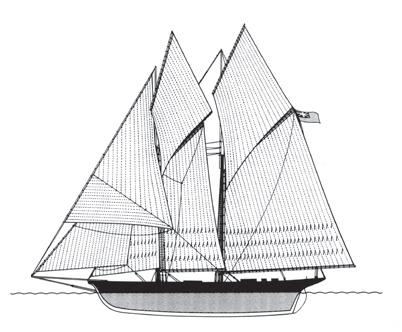
Livonia ‖ Royal Harwich
LOA: 127ft LWL: 106ft 6in beam: 23ft 7in draft: 12ft 6in displacement: 280 tons sail area: 18,153sq ft owner: James Ashbury designer: Michael Ratsey builder: Michael Ratsey skipper: J. R. Woods Columbia tacks round the stake-boat as the crew on the staggering Livonia, which has gybed from the other side, struggle to control her.
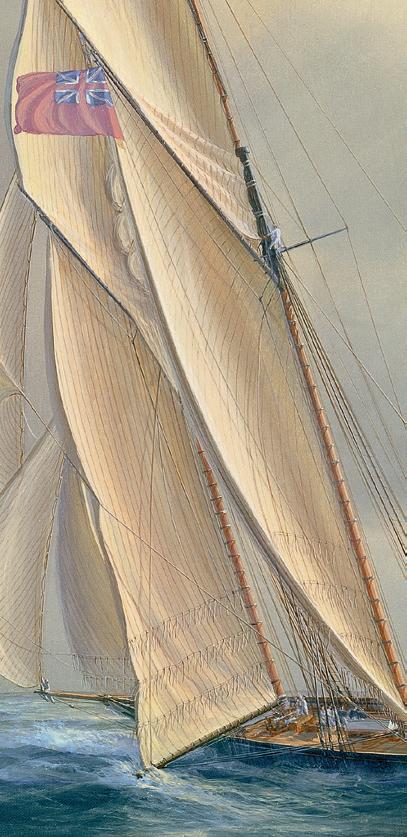
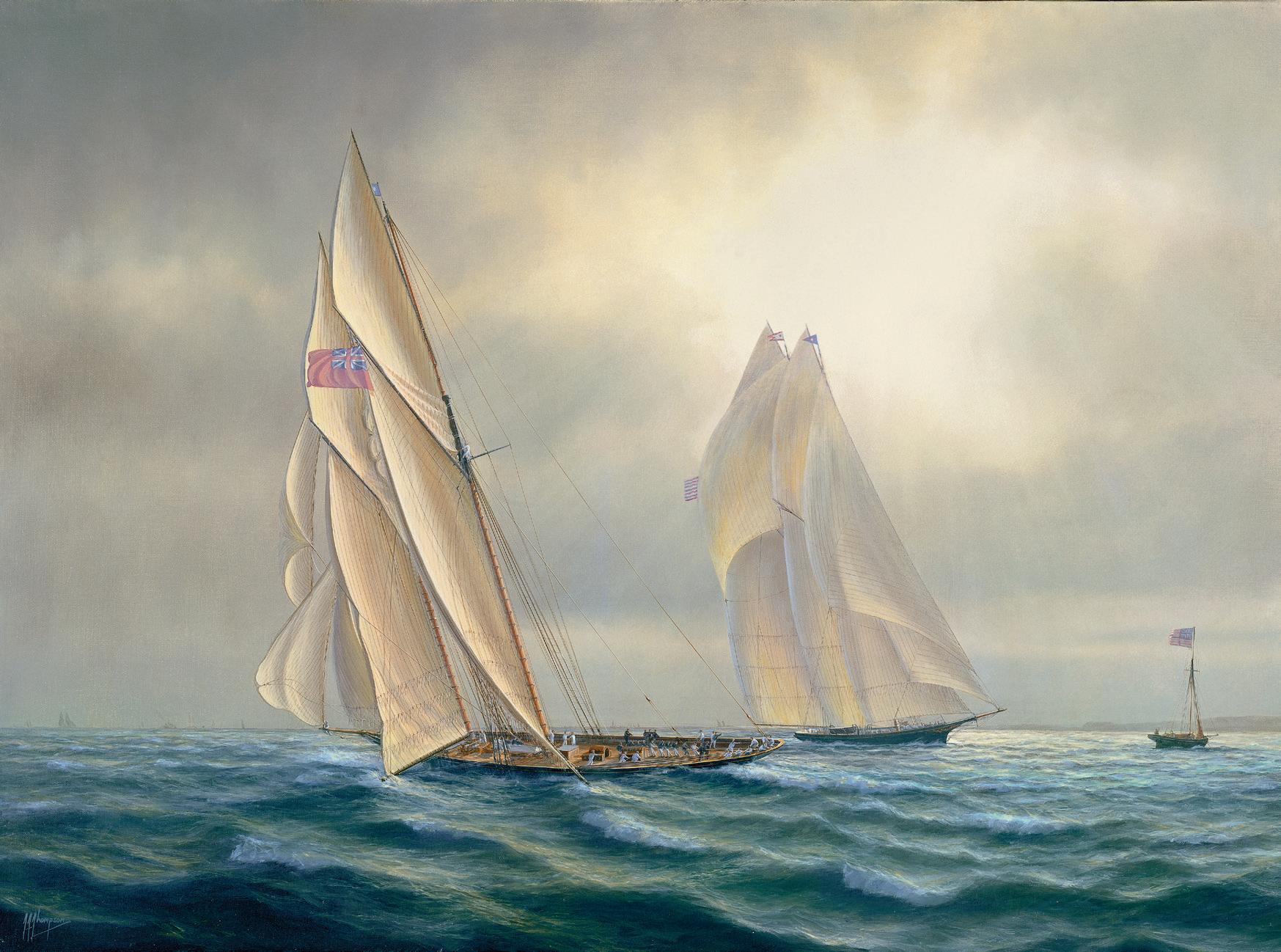
1876 madeleine defeats countess of dufferin
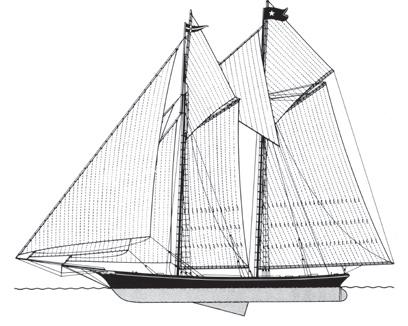
Madeleine ‖ New York Yacht Club
LOA: 106ft 4in LWL: 95ft beam: 24ft 3in draft: 7ft 3in draft with board: 19ft 6in displacement: 152 tons sail area: 17,231sq ft owner: John S. Dickerson designer: David Kirby builder: David Kirby skipper: Josephus Williams
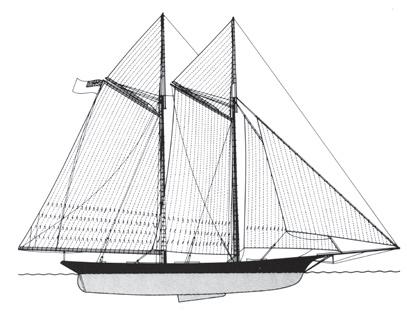
Countess of Dufferin ‖ Royal Canadian
LOA: 107ft LWL: 74ft 7in beam: 24ft draft: 6ft 6in draft with board: 18ft displacement: 138 tons sail area: not known owner: Major Charles Gifford & syndicate designer: Alexander Cuthbert builder: Alexander Cuthbert skipper: J. E. Ellsworth Interest in yacht racing had increased greatly as a result of the first two challenges for the America’s Cup; but although it was felt that Ashbury’s claim to the Cup was ludicrous, at the same time many believed that he had been unfairly treated in America and it was a waste of time and money to take a yacht over there again. It was therefore hardly surprising that no new British challenger materialised, and that it was left to others to try their hands.
Five years passed before Major Charles Gifford, Vice-Commodore of the Royal Canadian Yacht Club, formed a syndicate and submitted a challenge for the already famous trophy, and when he asked for the six months’ notice to be waived, the New York Yacht Club, in generous mood, not only assented but also offered him the opportunity of three deciding races instead of one. Where Ashbury had failed, Gifford, determined to succeed, had asked for one further concession, and when this was omitted from the Club’s reply, he wrote to them again complaining of their unfair advantage with so many yachts to choose from, and suggesting that in future they should agree to nominate just one. Amazingly, and by eleven votes to five, they did.
Gifford’s entry, the 107ft (32.6m) Countess of Dufferin, had been ‘specially designed’ for the occasion by Captain Alexander Cuthbert, a not very imaginative fellow, who had almost certainly ‘stolen’ her lines from a New Jersey boat-builder. But although he felt that she had an excellent chance of winning, and the Dominion newspapers were full of flattery, the Americans thought otherwise. Commanded by Gifford, but sailed by Cuthbert, the Countess set out from Ontario via Quebec early in June, and having negotiated the St Lawrence River she skirted the coast of Nova Scotia, arriving in New York, after an uneventful passage, in mid July.
The press immediately had a field day. ‘There is nothing foreign about her,’ quoted one leading journalist. ‘Her shape is American, her rig is American, her blocks are the Waterman patent of New York. Her steering gear is of New York manufacture, and from stem to stern, inside and out, alow and aloft, she is simply a Yankee boat built in Canada.’ Perhaps that would have passed if others had not described her hull ‘as rough as a nutmeg scraper’, and her sails ‘like a purser’s shirt on a handspike’. Indeed to critical eyes the Countess’s many defects were more reminiscent of a clumsy coaster than of a racing schooner intent on snatching the America’s Cup, and it was in this atmosphere that the New York Yacht Club set about choosing a defender from the large number of vessels believed capable of beating her.
There were already five yachts on the New York Yacht Club shortlist, Columbia, Palmer, Tidal Wave, Idler and Madeleine, but on the day of the first-ever American elimination race only Madeleine and Idler showed up. Madeleine won convincingly and the committee had no hesitation in selecting her to defend the Cup. In contrast to the Countess of Dufferin, which she equalled in size, the schooner Madeleine, owned by John S. Dickerson, Commodore of the Brooklyn Yacht Club, had been splendidly prepared and expertly manned. Built as a sloop eight years earlier in 1868, she had since undergone extensive alterations, and from 1873, when she was said to have won every race in which she started, she had built up a formidable reputation.
Madeleine’s first opportunity to get the measure of her opponent came in the Brenton Reef race, when the Countess, having sportingly taken on four other schooners over a long ocean course, finished so far behind that it was thought she had foundered. Her performance was so bad that Gifford asked for the Cup races to be postponed so that he could get some new sails cut and generally get her smartened up. The New York Spirit of the Times later reported: ‘Her owner had not been here many days before he saw that his yacht was a monstrosity. He at once called to his aid all the yachting skill which New York possessed, and completely transformed his yacht: booms were lengthened out, clouds of canvas were fitted, a full crew of the choicest Yankee tars were selected, and the best sailing master in New York was engaged.’ In truth the Americans and the New York Yacht Club had been more than helpful, but was it enough?
It had finally been arranged to hold the first race over the New York Yacht Club inside course of 11 August. Madeleine had been towed down from Greenwich, Connecticut, where her copper bottom had been treated with oil and tallow to make her slide easily through the water, and the Countess, which had been hauled out at Port Richmond, had also had her bottom potleaded and generally given a thorough manicure.
It was to be the first occasion on which the start was under canvas, and as the two contenders crossed the line and beat southwards into the moderate breeze, the audience on the twelve excursion steamers and about twenty yachts, including the old America, were treated to a grand spectacle.
Although Madeleine was not slow to show her paces, it was commendable that the Countess kept her in sight, and when the Yankee schooner, partly because of the heavy swell, overstood the lightship, Countess did by far the better turn, passing it only five minutes behind. But she never made up the deficit, and having lost the second race to Madeleine by more than twentyseven minutes, and by nineteen minutes to the twenty-five-year-old veteran, America, which on this occasion was timed, though of course hors concours, everyone agreed that enough was enough!
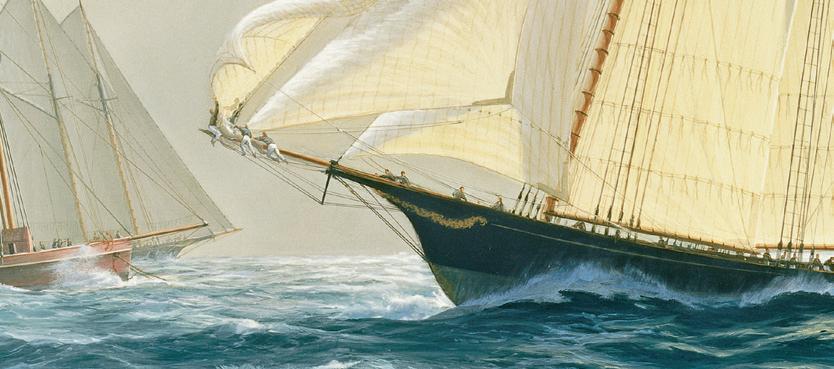
Madeleine rounds the Sandy Hook lightship, and as her crew struggle to set more sail, the Countess of Dufferin, followed by old America, which is only out for the ride, looms up behind.
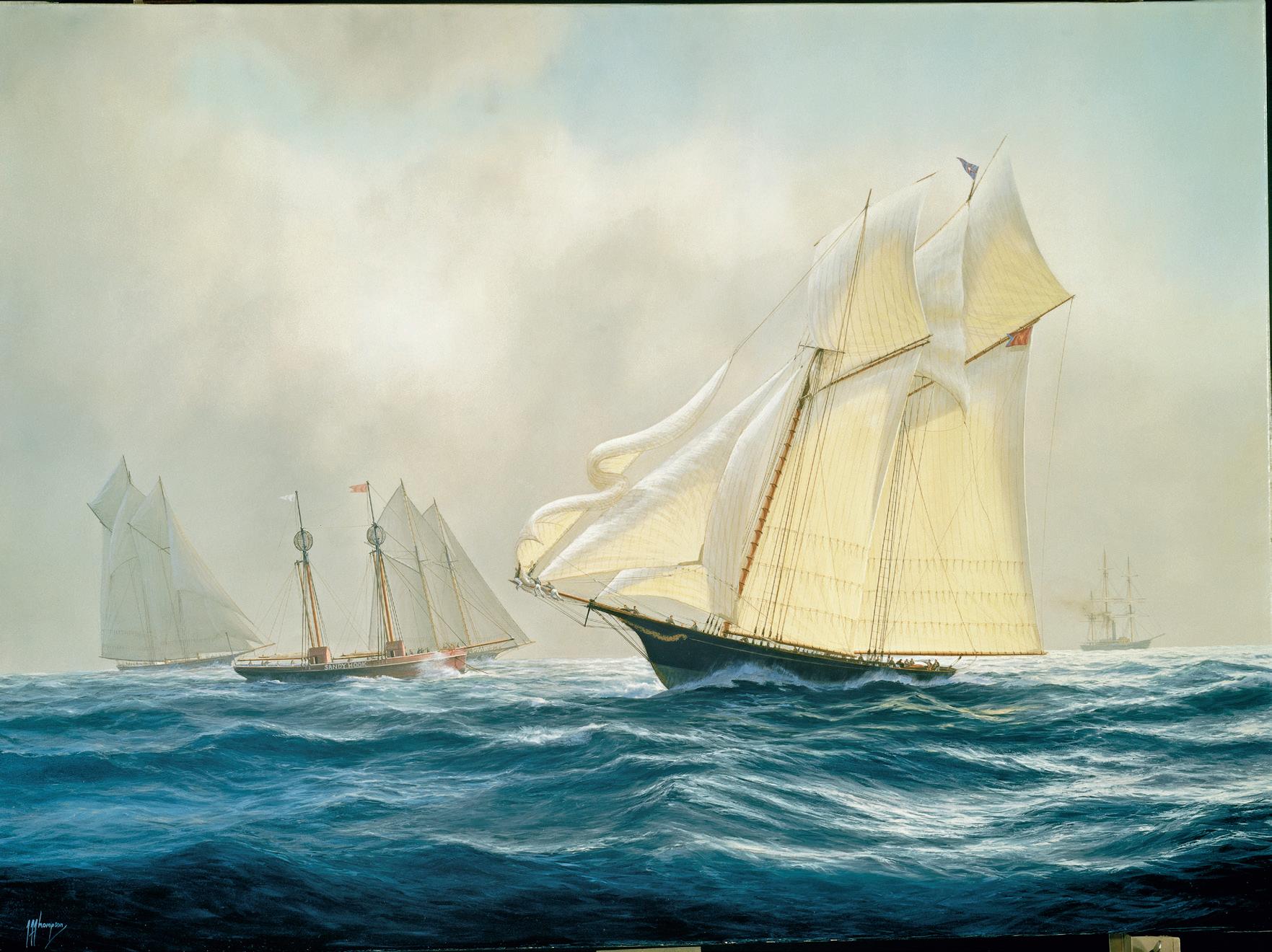
1881 mischief defeats atAlanta
Mischief ‖ New York Yacht Club
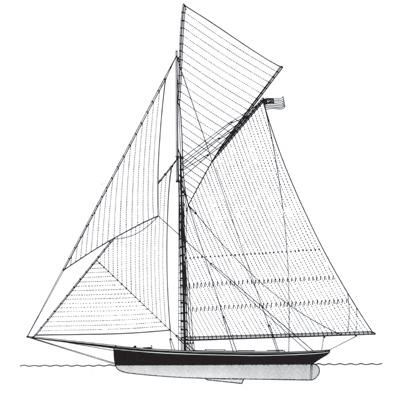
LOA: 67ft 5in LWL: 61ft beam: 19ft 10in draft: 5ft 6in draft with board: 16ft displacement: 79 tons sail area: not known owner: Joseph Busk designer: A. Cary Smith builder: Harlan & Hollingsworth skipper: Nathaniel Clock
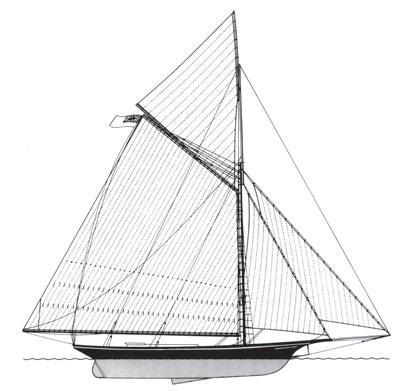
Atalanta ‖ Bay of Quinte (Canada)
LOA: 70ft LWL: 64ft beam: 19ft draft: 5ft 6in draft with board: 16ft 6in displacement: 84 tons sail area: not known owner: Alexander Cuthbert designer & builder: Alexander Cuthbert skipper: Alexander Cuthbert The second Canadian challenge was not received until well into 1881, when the Secretary of the tiny Bay of Quinte Yacht Club of Belleville, Ontario was asked by a syndicate, headed by Mr Albert Cuthbert, to submit a challenge requesting that ‘in consequence of the season being so far advanced, the six months’ notice be waived’. It seemed that late challenges were becoming a habit. Or was it perhaps that the challengers were trying to catch the New York Yacht Club off guard, without suitable boats for the Cup? In the event the NYYC accepted, for judging by the unimpressive first Canadian challenge, it did not really seem to matter.
Not all Americans thought the same way, however, and for the first time in the Cup’s history a yacht, Pocahontas, was built especially for the defence. It was also the first occasion that it was considered necessary to hold trial races, and after the wretched Pocahontas had been sent packing it was left to Mischief to narrowly gain selection from Gracie and Hildegarde. The days of the great schooners were already numbered, so 1881 also heralded the first Cup match between single-stickers, and yet another first was scored by Mischief, which was the first metal boat ever to defend the Cup, and only the second such yacht to have been built in America.
Most of the summer had gone by before the challenger took to the water. She was constructed of wood and designed by Cuthbert himself, who had also been responsible for the Countess of Dufferin. Instead of being sailed to New York by the ocean route, she was towed from the Great Lakes, at times by mule, through the Erie Canal. On occasions, when she proved too wide for the lock gates, her ballast had to be shifted to one side, and by the time she arrived down the Hudson River it was 30 October, and long after the yachting season had closed.
Cuthbert had named his new boat Atalanta after the daughter of a mythical Greek king, who had promised to marry any man who could sprint faster than herself but to have put to death all those who tried and failed. Judging, however, from her finish, described by one journalist as ‘rough as a hedge fence’, and her badly fitting suit of sails, it appeared unlikely, right from the outset, that Yankee heads would roll, and even more doubtful that any of them would be prepared to fall in love with her!
Mischief, although often referred to as ‘The Iron Pot’, was a prettier and better finished boat altogether, and she was considered to be one of the most competitive yachts in the world. Owned surprisingly by an Englishman, Captain Busk, she had much greater depth than other American yachts of that period and, aided by a centreboard let down through her keel, she was considerably more stable. It was just as well, for by the time that the races were eventually held the weather had broken completely, and the series was only noted for its fog, lashing rain and high winds.
The first of the best of three races was delayed until 9 November when, watched by only a handful of spectators, the two yachts ploughed off up the inside course, closely followed by Gracie, which had been given permission to go along for the ride. The largely amateur crew of inshore Canadians, who had alone taken a reef in their mainsail, were quickly overhauled by both American boats, and ultimately they were left so far astern that the committee did not even bother to wait for them!
As a result, so little interest was shown in the second race that only a solitary sidewheeler was in attendance, and she soon went home. But although this too was a disaster for the Canadians, who lost their spinnaker pole and finished over forty minutes behind both Mischief and Gracie, it was to be remembered by the committee for other reasons.
After two days of dirty weather, the morning had dawned magnificently, with a fresh breeze blowing from the north-west. At 8am the tug Luckenbach, having picked up the race committee from pier No 3 on the East River, had made for Staten Island where they were to rendezvous with the two contestants and tow them immediately to the start. Mischief, waiting off Tompkinsville, secured her line, but when it was found that Atalanta was not ready, she cast off again and made her own way out to sea. It was almost an hour later when Captain Cuthbert and his merry crew appeared at last on the jetty, and the committee were not a little upset on discovering that the Canadians had only just been taking a very leisurely breakfast!
The Spirit of the Times summed up the result as follows: ‘The Mischief distanced the Atalanta, a new yacht, hastily built, totally untried, and miserably equipped with misfitting sails, which was bungled round the course by an alleged crew, who would have been over-matched in trying to handle a canal-boat in a fog—only this, and nothing more.’
When Cuthbert, undaunted by his drubbing, declared his intention to challenge for a third time the following season, the New York Yacht Club had no alternative but to change the rules by banning all clubs without an ocean regatta course from ever competing again.
The tug Luckenbach stands by as members of the committee look for the crew of Atalanta. Mischief meanwhile puts to sea and Gracie, riding the floodtide like a racehorse, makes for the distant starting line.
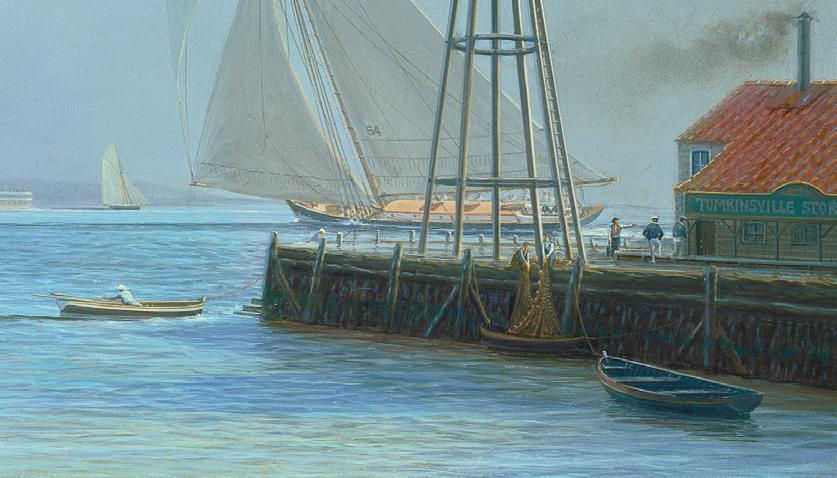
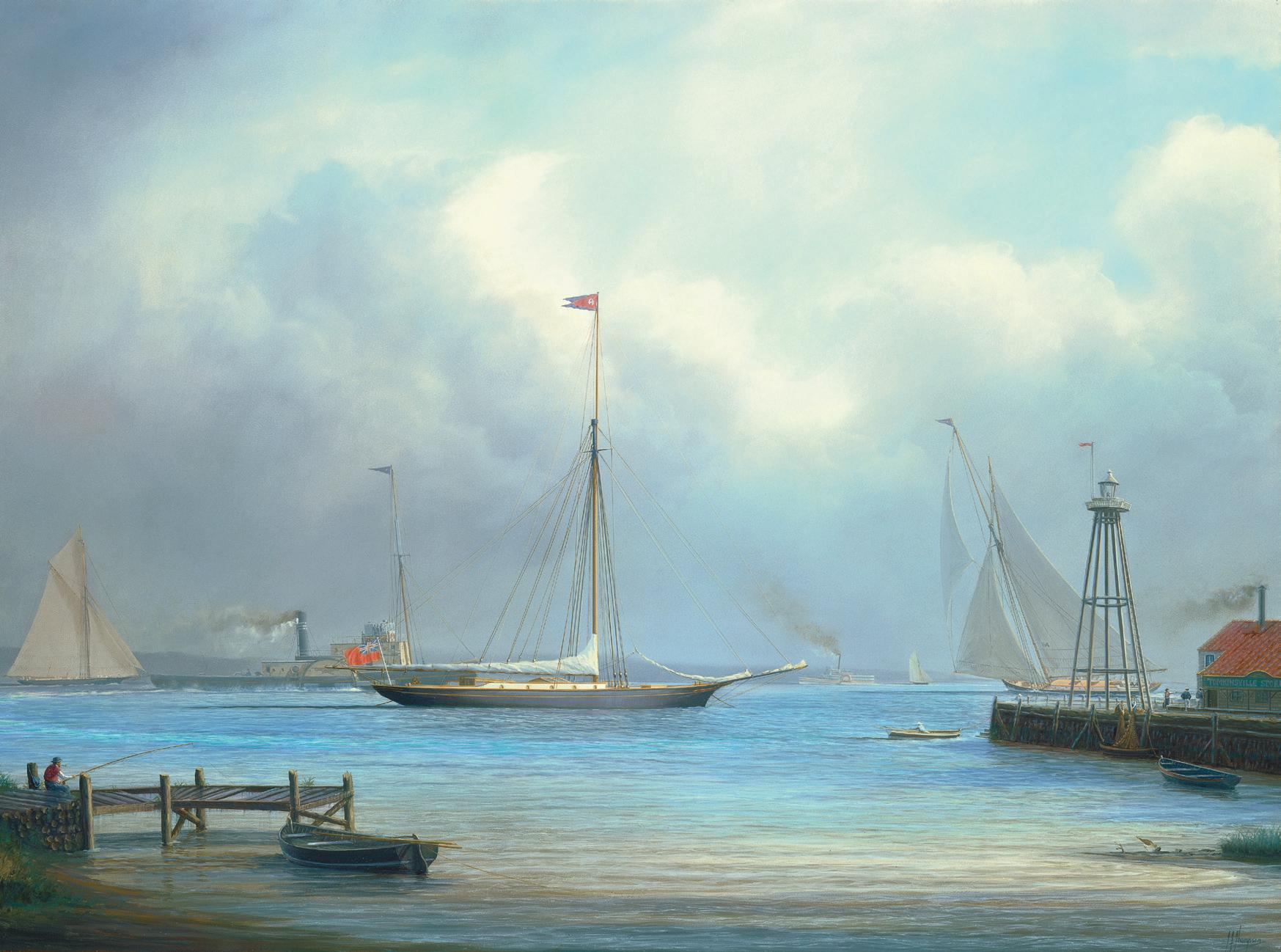
1885 puritan defeats genesta
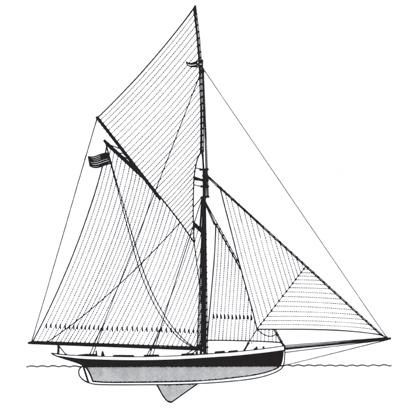
Puritan ‖ New York Yacht Club
LOA: 94ft LWL: 81ft 1in beam: 22ft 7in draft: 8ft 8in draft with board: 20ft displacement: 140 tons sail area: 7982sq ft owner: J. Malcolm Forbes and General Charles J. Paine & syndicate designer: Edward Burgess builder: George Lawley & Son skipper: Aubrey J. Crocker
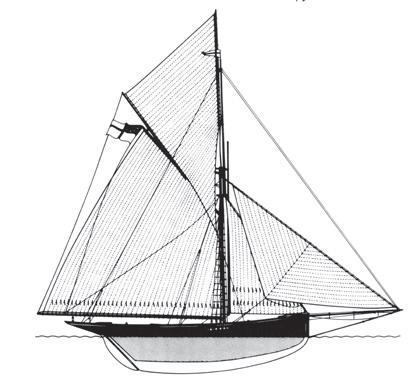
Genesta ‖ Royal Yacht Squadron
LOA: 96ft 5in LWL: 81ft 7in beam: 15ft draft: 13ft 6in displacement: 80 tons sail area: 7150sq ft owner: Sir Richard Sutton designer: J. Beavor-Webb builder: D. & W. Henderson skipper: John Carter In February 1885 an official challenge was received by the New York Yacht Club from the British Designer J. Beavor-Webb on behalf of the Royal Yacht Squadron and Sir Richard Sutton, owner of the cutter Genesta. Previously Beavor-Webb had written to the Secretary of the Club suggesting that owners of two of the boats he had designed would like to challenge for the Cup and it had been agreed that if Genesta was defeated, Galatea, owned by Lieutenant William Henn, RN, would race for the America’s Cup the following year.
In 1882 George L. Schuyler, the only surviving member of the first America’s Cup syndicate, had been asked to draw up ‘the second Deed of Gift’, amending the rules to ensure that the America’s Cup continued not only as a test of speed but also one of endurance. The 1881 challenger, Atalanta, had been towed to New York all the way from Canada, and this was no longer considered ‘cricket’, nor were challengers to be allowed to arrive as deck cargo on the increasing number of steamers capable of carrying them. The new rules, circulated to all foreign yacht clubs, stated that in future only large sea-going yachts, which had arrived under sail on their own bottoms, would be acceptable, and the New York Yacht Club would require six months’ notice from any challenger in order to give them time to choose a suitable opponent.
The British cutter made her first appearance in May 1884, when she defeated all opposition at the New Thames Yacht Club regatta. Because of her deep, narrow hull and tapered stern Genesta was described by the press as ‘an exceptionally attractive yacht with slim lines, likely to be a slippery customer’, and before long news of her successes was being cabled across the Atlantic.
The American yachts, known as ‘skimming dishes’ at that time, were as different from the British ‘planks on edges’ as the America had been from the British boats in 1851, and the two sloops built to defend the Cup were both beamy and shallow. Instead of the deep keel favoured by British designers, the yachts were fitted, for the first time, with a combination of leaded keel and the traditional American centreboard. They were named Priscilla and Puritan. Selection trials were sailed during the summer of 1885, resulting in Puritan being chosen to represent America in the coming contest. She had a mast of Oregon pine and a bowsprit, not unlike that of Genesta, 38ft (12m) long.
When Genesta arrived in American waters she was watched with interest, but her skipper, Captain Carter, carefully avoided any brushes with the opposition. Before the first race, which was to be held on the inshore course south of New York, Genesta was hauled out and her copper bottom was burnished to a mirror finish.
The first race had to be postponed because of lack of wind, but it was held on the following day, 8 September. The clear cloudless sky, and the promise of magnificent weather for the race, drew a large fleet of spectator craft to the start off the Scotland lightship, and they were soon to be rewarded by witnessing one of the more chivalrous events in the Cup’s history.
Both yachts, as they waited for the starting whistle, made for the line on different tacks. Genesta, moving fast on the starboard tack, had right of way, and when she was crossed by Puritan, whose skipper, either miscalculating or intending to bluff, shaved her bow, Captain Carter quite correctly held his course. Although Puritan’s skipper tried to luff, he had no chance, and running from the helm as Genesta’s long bowsprit ripped through the clew of his mainsail, he was lucky to escape with his life. The leech rope on Puritan, however, failed to part, snapping off Genesta’s bowsprit at the gammon like a rotten carrot and leaving her out of action.
Sir Richard Sutton hailed the committee boat, which quickly steamed towards Genesta, and asked how much time he had for lodging a written protest. But Mr Tams, an official, shouted back: ‘We have ruled the Puritan out; if you choose to sail the race you are free to do so.’
After more questioning the committee were asked by a member of Genesta’s crew: ‘Will you give us time to rig up a spinnaker boom for a bowsprit?’ But while the committee were deliberating on this point, Sir Richard Sutton put a sudden end to the discussion by saying: ‘We are very much obliged to you, but we don’t want it in that way. We want a race; we don’t want a walkover.’ This decision was quite satisfactory to the committee and their steam tug Luckenbach took the Genesta in tow and dropped her at Staten Island.
Both boats were repaired and ready to sail in time for the next race, which had been postponed until 11 September, but once again the wind had dropped away and the race had to be abandoned. On 14 September the race was at last started off Owl’s Head, and as the tide carried the two boats past Long Island there was a mighty cheer for Genesta and her gallant young owner from the huge crowd gathered at the forts on either side of the Narrows.
Sadly, Genesta lost the race by over sixteen minutes and also the decisive second race held two days later. But although the British had failed yet again to produce the best boat, the magnanimous decision of Sir Richard Sutton not to accept a sailover set a high point in America’s Cup sportsmanship.
An American correspondent writing about the event said: ‘Hitherto we had regarded the challengers as ruffians, and as ruffians we had dealt with them, but now a wave of good feeling towards them has swept over the country.’
Sir Richard Sutton, wearing his favourite pink boating jacket, watches in horror as Genesta’s long bowsprit lunges through Puritan’s mainsail.
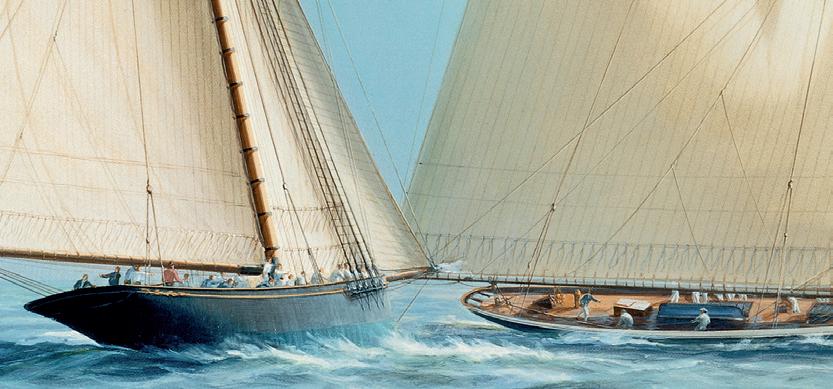
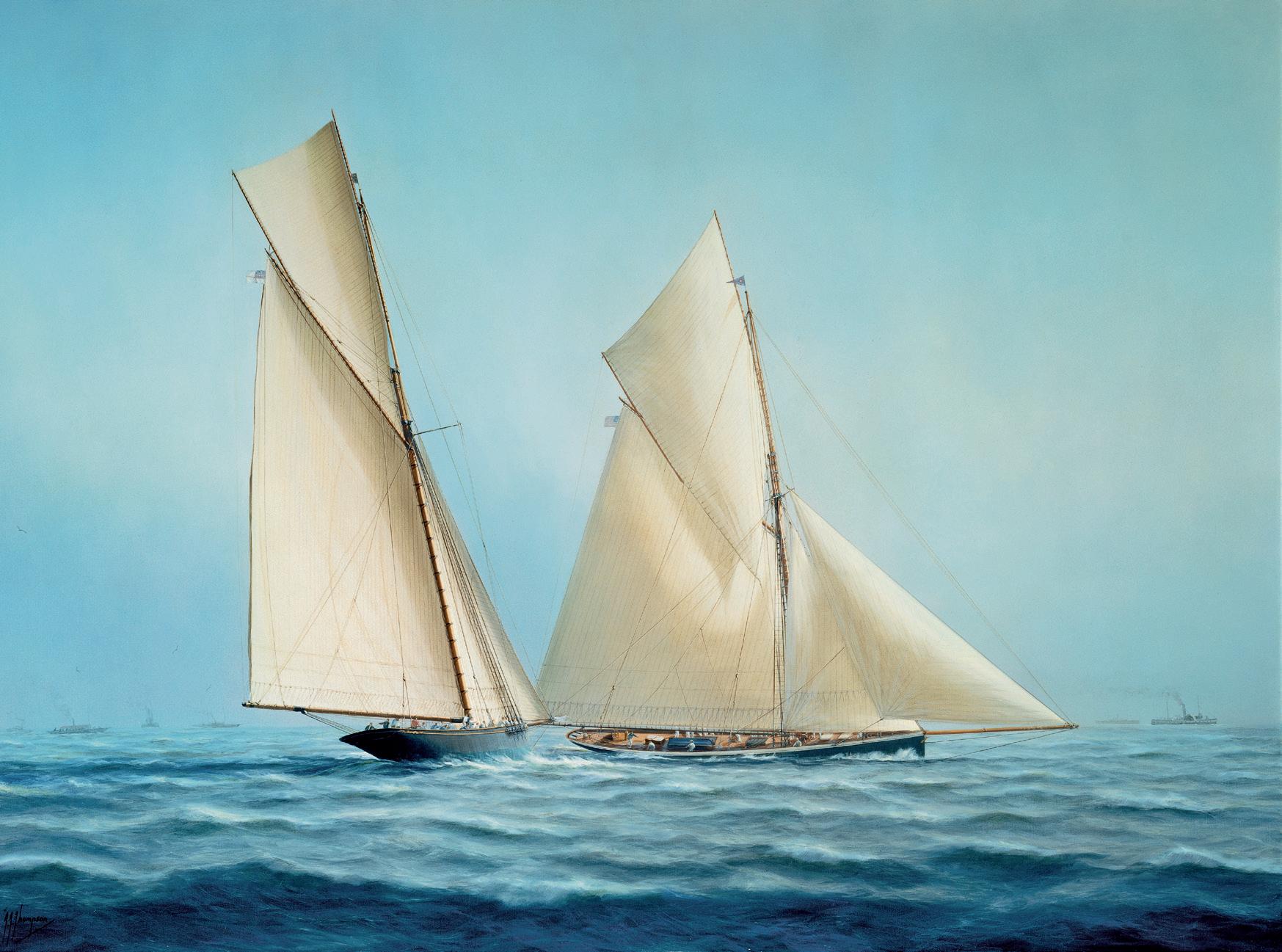
1886 mayflower defeats galatea
Mayflower ‖ New York Yacht Club
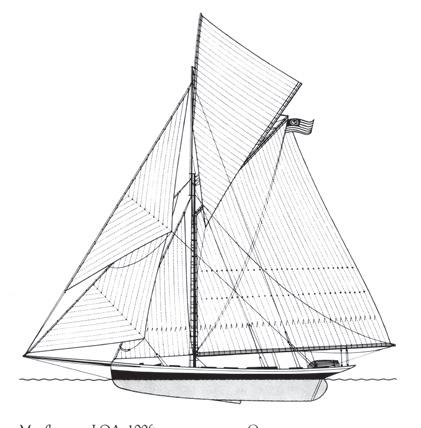
LOA: 100ft LWL: 85ft 6in beam: 23ft 6in draft: 9ft 9in draft with board: 20ft displacement: 110 tons sail area: 8600sq ft owner: General Charles J. Paine designer: Edward Burgess builder: George Lawley & Son skipper: Martin Stone
Galatea ‖ Royal Northern
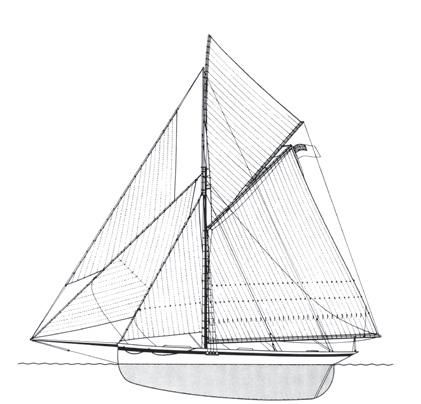
LOA: 102ft 7in LWL: 86ft 10in beam: 15ft draft: 13ft 6in displacement: 158 tons sail area: 7505sq ft owner: Lt William Henn RN designer: J. Beavor-Webb builder: J. Reed & Son skipper: Dan Bradford Lieutenant William Henn’s challenge with Galatea in 1886 was probably more as a result of the designer’s ambitions than those of the yacht’s stolid owner. J. Beavor-Webb, who had designed Genesta the previous year, and who had convinced himself that his second boat was faster, was determined to pursue this double attempt regardless of a great deal of advice to the contrary.
Galatea had been named by Henn after a ship on which he had served in the Royal Navy. In Greek mythology, Pygmalion had carved a statue of a lovely damsel he called Galatea, and when he fell in love with it, Aphrodite had generously brought the statue to life. The ‘tin frigate’, as she was named, was loved almost as much, and certainly she was brought to life by Henn in every sense of the word. Henn and his wife, in contrast to any other challengers for the Cup before or since, lived on board Galatea. They had, moreover, surrounded themselves with a museum of Victorian bric-a-brac and a zoo consisting of several dogs, a lemur, and a monkey called Peggy, more of whom we shall hear later. Galatea would have been better nicknamed the ‘Noah’s Ark’.
Before leaving for America Henn, who was a cruising man by nature, entered his pride and joy in several races, but when she failed to win it was discovered that the lead had been incorrectly poured into her keel, which was full of holes and leaking. Once she had been repaired, he raced her three more times, but, when she had no better success, he decided without more ado to cross the Atlantic, arriving off Marblehead on 1 August 1886, after a leisurely trip of some thirty days.
The Yankees were waiting for him. Four American sloops had been prepared for the honour of defending, including Puritan, winner in 1885, Priscilla, which had not been nominated on that occasion, and two new boats, Atlantic and Mayflower. In general appearance Puritan and Mayflower were very much alike, and ultimately it was these two that were left to fight it out. Both constructed of wood, they had the same straight stem and the same graceful overhanging stern, and both were rigged like British cutters, except that their bowsprits did not reef. After losing her first three races, Mayflower, which had the finer entrance, proved superior in a head sea, and having won on 7 August at the Sow and Pigs, she never failed again.
Soon after his arrival, Henn joined the New York Yacht Club cruise from Buzzard’s Bay. Painted white, with her ‘Jack-yard’ topsail and the rest of her well-cut canvas set, Galatea looked pretty in the light breeze, but any attempts by members of the Club to gauge her strength were foiled by her genial owner, who insisted at all times on towing a dinghy. Finally, when they tried to corner him, Henn threw down a challenge for any single-sticker to race him to Bermuda and back, but nobody called his bluff, or was confident enough to tackle the blue water.
General Charles Paine, who had also commissioned Puritan, engaged Captain ‘Hank’ Haff to skipper his new defender Mayflower, and as soon as the trial races were concluded, they hauled her out for a final polish. Paine, who was a stickler for crew discipline and efficient sail trimming, although confident that he had the leading skipper of that era, insisted on being on board for all her races, and when she was later, on 7 September, towed to the starting line off Owl’s Head, he paraded Mayflower like a cavalry charger.
Galatea, on the other hand, had remained the sort of dark horse that might at any moment develop qualities unbefitting to the battlefield. Already the grog was being passed round, and it was not obvious that the British cutter had any intention of starting at all. But such was her owner’s indifference that she had quietly gained a great deal of support, and when she surprisingly shot over the starting line in the lead, a cheer went up which was almost heard in Manhattan.
The weather had started foggy but cleared as the morning grew older, the sun breaking out as the two boats set off down the inside course into a light southerly breeze. Both yachts had crossed the line on the starboard tack, and as they headed for the narrows the strong flood tide set them to leeward and into the host of spectator craft, including a large anchored schooner. Mayflower had been pointing higher than Galatea, and fortunately for Haff he was able to luff round the obstacle and keep up his momentum. But for Beavor-Webb life was not so easy. Forced under the schooner’s lee, he was badly blanketed, and as Mayflower passed them, only Peggy, the monkey, seemed to know what to do, and leapt off along Galatea’s lengthy bowsprit, determined to lower the sails. She might just as well have done so.
When Mayflower eventually tacked for the Sandy Hook lightship, she was already well ahead, and as she rounded and broke out her big jib topsail, more than a hundred steam whistles sent her hurrying home to a comfortable win.
The second and deciding race was no different. Galatea seemed to slide off to windward, and Mayflower, with her more effective centreboard, won again by a wide margin. Henn, who was absent due to illness, had asked for the course to be shortened so that he could take part on his way to see the doctor, but the New York Yacht Club, saying that they were unable to change the rules, had refused. So, disappointed, he decided to keep his yacht in America for another season, winning few trophies, but enhancing his reputation for sportsmanship all the time.
Peggy waits to bring in the jib. The monkey was used to joining in on the ropes with the crew—Galatea’s skipper considered she was descended from man!
